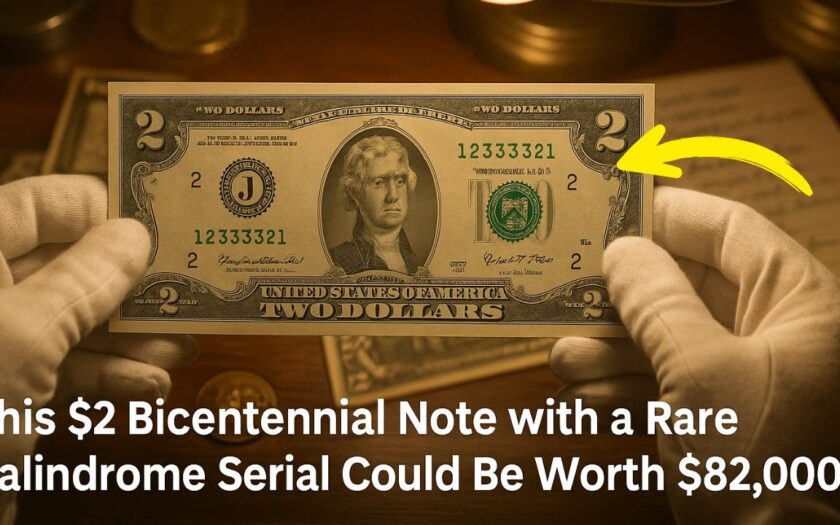In the world of numismatics, certain currency notes transcend their face value, becoming prized collectibles due to unique features.
One such example is the 1976 $2 Bicentennial note featuring a rare palindrome serial number, which recently fetched an astounding $82,000 at auction.
This article delves into the details of this remarkable bill, exploring its design, rarity, and the factors contributing to its significant value.
Understanding the 1976 $2 Bicentennial Note
Historical Context
The 1976 $2 bill was issued to commemorate the United States’ Bicentennial, marking 200 years since the Declaration of Independence. Unlike most U.S. currency, the reverse side of this bill depicts John Trumbull’s painting, The Declaration of Independence, rather than the traditional image of Monticello. This design choice was made to honor the nation’s 200-year history and to celebrate the founding fathers.
Design and Features
- Obverse: Portrait of Thomas Jefferson, the third President of the United States.
- Reverse: Depiction of the signing of the Declaration of Independence.
- Material: 75% cotton and 25% linen blend, ensuring durability.
- Dimensions: 6.14 inches by 2.61 inches.
- Security Features: Green Treasury seal and serial numbers, black and gray detailing on Jefferson’s portrait.
Despite its unique design, the $2 bill was not widely circulated, leading to a misconception about its rarity. In reality, millions were printed and remain in circulation today.
What Makes a Palindrome Serial Number Special?
Definition
A palindrome serial number reads the same backward as forward, such as 12344321. In the context of currency, these are also known as “radar notes.” Their symmetrical nature makes them visually appealing and highly collectible.
Rarity and Value
While palindrome serial numbers are rare, their value is influenced by factors such as condition, demand, and the specific pattern of the numbers. For instance, a 1976 $2 bill with the serial number B18066081A recently sold for $130, indicating a niche market for such collectibles.
Factors Contributing to the $82,000 Sale
Uncirculated Condition
The condition of a bill plays a crucial role in its value. An uncirculated bill, free from folds, creases, or discoloration, is significantly more valuable than a circulated one. The $82,000 palindrome serial number note was in pristine condition, enhancing its appeal to collectors.
Unique Serial Number Pattern
The specific pattern of the palindrome serial number can impact its desirability. Patterns that are more symmetrical or have cultural significance tend to fetch higher prices. The exact pattern of the $82,000 note contributed to its exceptional value.
Market Demand
The numismatic market’s demand for unique and rare items drives prices upward. Collectors are often willing to pay a premium for items that fit specific criteria, such as rare serial numbers or historical significance. The combination of these factors led to the record-breaking sale of the $82,000 bill.
Comparative Analysis: Other Notable Sales
| Serial Number | Sale Price | Notes |
|---|---|---|
| B18066081A | $130 | Palindrome serial number, uncirculated condition. |
| 12121212 | $78,000 | Repeater serial number, uncirculated condition. |
| 00000001 | $500,000+ | Low serial number, uncirculated condition. |
These examples illustrate the premium prices that certain serial numbers can command in the market. The $82,000 sale of the palindrome serial number note is among the highest for a $2 bill, underscoring the significance of unique serial numbers in determining value.
How to Identify and Value Your $2 Bills
Step 1: Examine the Serial Number
Look for patterns such as:
- Palindromes: Numbers that read the same backward and forward.
- Repeating Numbers: Sequences like 12121212.
- Low Numbers: Serial numbers with fewer digits, such as 00000001.
- Star Notes: Replacement notes marked with a star symbol.
Step 2: Assess the Condition
Use the following grading scale:
- Uncirculated: No signs of wear, crisp edges, and vibrant colors.
- Extremely Fine: Minor folds or creases, but overall excellent condition.
- Fine: Noticeable wear, folds, and creases.
- Good: Significant wear, tears, or discoloration.
Step 3: Consult a Professional
For a precise valuation, consider consulting a professional numismatist or using reputable online platforms to compare similar sales.
The $82,000 sale of the 1976 $2 Bicentennial note with a rare palindrome serial number highlights the intricate world of currency collecting. Factors such as the bill’s condition, unique serial number, and market demand converge to create exceptional value. For collectors, understanding these elements can lead to the discovery of hidden treasures within everyday currency.
FAQs
What is a palindrome serial number on a $2 bill?
A palindrome serial number is a sequence of digits that reads the same backward and forward, such as 12344321.
Are all 1976 $2 bills valuable?
No, only those with unique features like rare serial numbers, uncirculated condition, or printing errors are considered valuable.
How can I determine the value of my $2 bill?
Assess the serial number for unique patterns, evaluate the bill’s condition, and consult with a professional numismatist or use online valuation tools.
